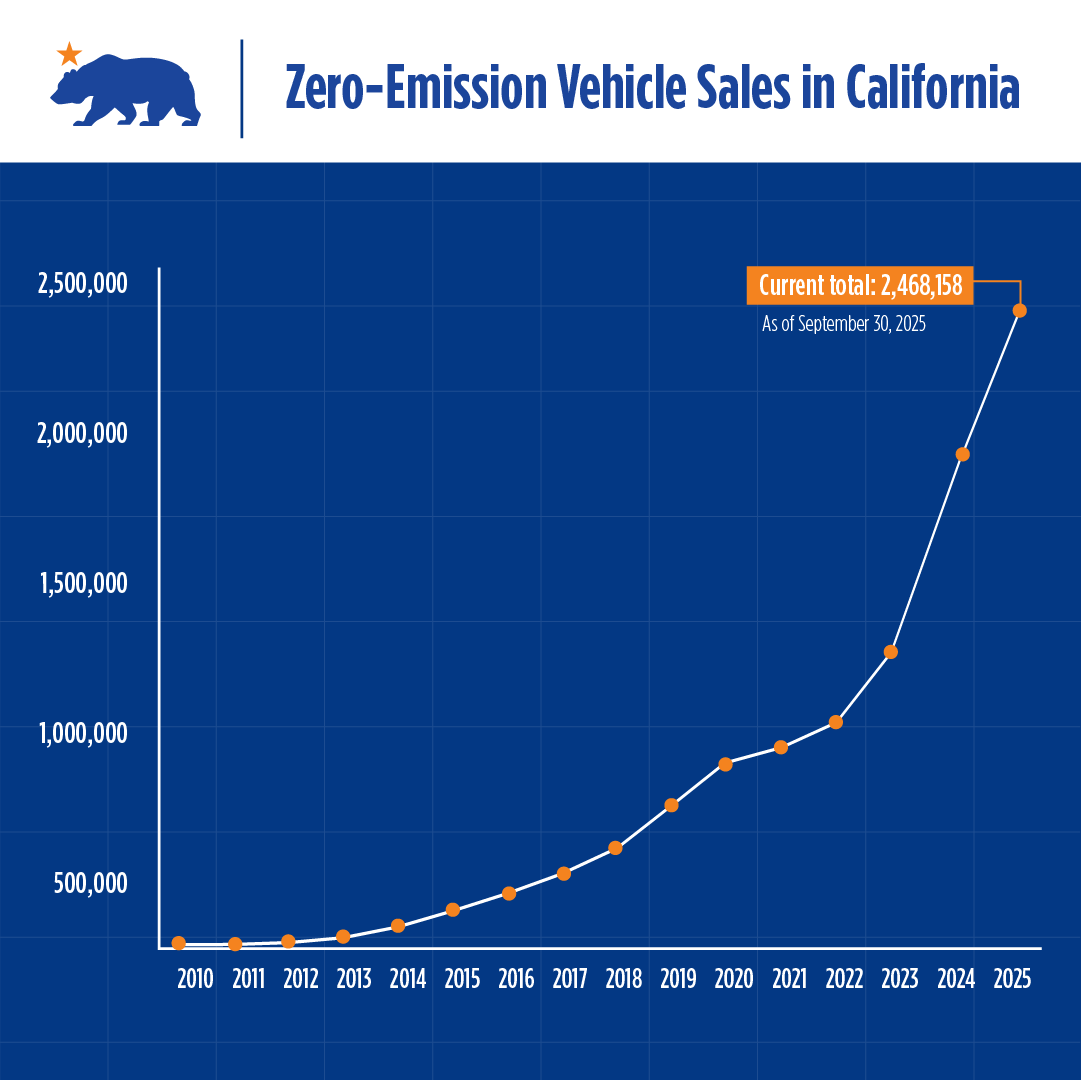For Immediate Release: Oct. 13, 2025
WHAT YOU NEED TO KNOW:
California’s demand for zero-emission vehicles (ZEVs) is surging despite federal attempts to derail the Golden State’s pursuit of a 100% clean energy future. A record 29.1% of all new cars purchased in Q3 of 2025 were ZEVs.
SACRAMENTO — Today, Governor Gavin Newsom announced that Californians purchased 124,755 zero-emission vehicles (ZEVs) in the third quarter of 2025, representing 29.1% of new car sales, the highest quarterly sales share ever reported in California. Despite the numerous setbacks to the ZEV industry brought about by the federal administration, Californians made it clear they want to drive ZEVs.
“This is unprecedented – we’re nearing a third of all new vehicles sold in the fourth largest economy on the planet being clean cars,” said Governor Gavin Newsom. “We’re setting new records because this state believes in innovation, not isolation. While Trump sells out American innovation to China, California will keep charging ahead on our path to a future of cleaner air.”
“This is a defining moment for California’s ZEV progress and sends a clear message to Washington: ZEVs are here to stay,” said California Energy Commissioner Nancy Skinner. “The work and investments by the California Energy Commission (CEC), and its agency and industry partners, to expand the state’s network of EV chargers has resulted in nearly every Californian living within 10 minutes of an EV fast charger. Now, new EV owners can enjoy a great driving experience bidding goodbye to smelly gas stations, messy oil changes, and costly engine tune-ups.”
"While the federal government stumbles backward with reckless rollbacks and short-sighted policies, California charges ahead lighting the path to a cleaner, more prosperous future,” said California Air Resources Board Chair Lauren Sanchez. “From pioneering clean transportation in the 1970s to becoming the world’s 4th largest economy today, we’ve proven time and again that protecting air quality and the climate isn’t just the right thing to do, it’s smart economic policy."
The ZEV market is also diversifying in California, with 146 ZEV models available in Q1, up from 105 models in Q1 of last year. Of the 124,755 ZEVs purchased in Q3, 108,685 of those were EVs. This is also a record for California, with EV sales spiking nearly 30% over Q2 2025. It’s clear Californians are confident in the growing network of EV chargers across the state and are buoyed by the choices available from auto manufacturers.
California Adopts First-in-Nation EV Charger Reliability and Reporting Regulations
California’s support for clean cars is unmatched. Despite federal headwinds, California has doubled down on improving the state’s charging network and making it easier than ever to own a ZEV:
- On October 8, 2025, California became the first state in the nation to adopt EV charger reliability and reporting regulations, laying the foundation for charging station reliability across the nation. The regulation will not only improve the reliability of publicly funded fast chargers but also enable accurate reporting on EV chargers operating in California.
- Also at its October 8 business meeting, the CEC approved two National Electric Vehicle Infrastructure (NEVI) Formula Program projects that will build out 64 fast chargers along key highway corridors to reduce range anxiety for travelers.
- CEC also approved two grant agreements to repair 30 publicly accessible chargers that are currently non-operational and install 30 new fast chargers at the same sites.
- And the CEC approved three grants totaling more than $10 million, which will build out more than 1,000 Level 2 EV charging ports, the vast majority in low-income, disadvantaged, or affordable multifamily housing complexes throughout the state.
- Grants and rebates for thousands of dollars are available for low-income Californians to purchase ZEVs. Learn more at ClimateAction.ca.gov or ElectricForAll.org.
California is tearing down barriers to ZEV deployment, speeding up ZEV charging station installations, and deploying infrastructure in hard-to-reach and low-income areas.
The Gold Standard for American EV Infrastructure
While qualifying for federal ZEV incentives contributed to the sales spike this quarter, becoming an EV driver in California is increasingly getting easier. There are now over 200,000 publicly accessible EV charging stations statewide. Chargers can be found at grocery stores, park and ride lots, and even gas stations, whereas shared chargers can be found at apartment complexes, workplaces, doctors’ offices, sports facilities, and other parking areas that may have some level of restricted access. This statewide network of public and shared private chargers is in addition to the estimated 800,000 EV chargers installed in single-family homes.
###
About the California Energy Commission
The California Energy Commission is the state's primary energy policy and planning agency. It has seven core responsibilities: advancing state energy policy, encouraging energy efficiency, certifying thermal power plants, investing in energy innovation, developing renewable energy, transforming transportation, and preparing for energy emergencies.
Newsroom
Media Contact
Media and Public Communications Office
MediaOffice@energy.ca.gov
(916) 654-4989

